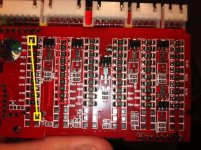Amazing how two tests can create such different results eh?
Or at least our impression of the results.
I have owned and played with most of the meters on the market. I had the first cell log before they had logging - what I remember about it was that it was a very sexy mechanical package. The feel of the plastic was like microfiber. It is a nice looking product - this is why people like it I suspect.
But... people do not test the precision. Some test the accuracy, but few the precision.
Looking at the cell log data the swing is not really that bad.
about 5mV on each channel right?
That is actually pretty good...
I suspect that the other meters are probably rounding or averaging results and that is why they stay still.
My guess is that they will make a larger jump once a threshold is stepped over.
Good job with that data. Now it is clear why I asked to see measurements from a calibrated DMM :wink:
Next test you might want to do would be to take your DMM into the lab at school and calibrate it against a known good DMM.
I did this at work as follows:
Grab two calibrated DMM's
Set up a spreadsheet
0.001V
0.01V
0.1V
1V
10V
100V
1000V
Take all those measurements with your DMM and the two calibrated DMM's
My guess is that you will find that your DMM is off by up to 1% and that value goes UP with voltage - so at 100V you may read 99V or 101V. Seems like no big deal until you are trying to measure a 24S pack that you want exactly at 100.8V. That type of measurement requires 0.1% accuracy to take. The scary thing is that your DMM will say 100.8V when it could be 101.8V or 99.8V. They display a higher degree of accuracy then they can measure which is misleading. They should just truncate that data to 100V or 99V.
I also found that my meter would have "resolution steps" as it moved through the auto-scale sections.
In the end I just memorized the offsets and mentally added them. For instance, when i was reading about 100V I knew that my meter would read about 1V low so I would add that in.
btw: This was like a Radio Shack DMM - maybe $30
Then do the same with current
1uA
10uA
100uA
1mA
10mA
100mA
1A
10A
My guess is that all of these readings will be right on.
Then.... once you graduate and get an awesome job watch Ebay and grab up a nice Fluke DMM.

My experience has been that if some dumb-ass blows the internal fuse they will sell it for cheap - not understanding that it is just a fuse.
Maybe $150 for a nice DMM with all the fancy features.
worth every penny.
-methods

